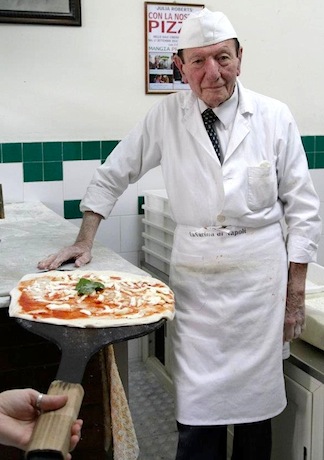“Celebration . . . is self-restraint, is attentiveness, is questioning, is meditating, is awaiting, is the step over into the more wakeful glimpse of the wonder—the wonder that a world is worlding around us at all, that there are beings rather than nothing, that things are and we ourselves are in their midst, that we ourselves are and yet barely know who we are, and barely know that we do not know all this.”
—Martin Heidegger
Having so far briefly considered the Neapolitan pizza within its historical and cultural contexts, it should be clear by now that, as I stated before: “By legacy, a pizzaiuolo napoletano is essentially a care, a burden, a culture-carrier!—carrying centuries of customs, traditions, and history that go beyond just a culinary phenomenon. . . . A pizzaiuolo napoletano is a custodian of the Neapolitan tradition that he has inherited.” Some of the pictures hereunder are amongst the most antique depictions of Neapolitan pizzaiuoli on the Internet. The pictures are quite revealing; they are silent and intangible manifestation of what German philosopher Martin Heidegger referred to as “Being and time”—which to him is a matter of celebration!
The pictures, below, are ordered chronologically, to the best of my knowledge, from past to present. The 1st picture (from Lessing Photo Archive) illustrates an ancient Roman mosaic, depicting a Roman baker (from the first half of 3rd century A.D.) who seems to be placing a bread dough inside a wood-fired oven. The Neapolitan ovens in service today strikingly appear similar to the oven in the picture. Although the Roman baker is no pizzaiuolo, he serves, if you will, as an archetypal image that surreptitiously glimpse into what was to come through waves of history!
The 2nd picture, origin of which is unknown, depicts a female who seems to be a Renaissance baker of some sort, baking what appears to be a flatbread, stuffed or not, inside a pan held over open fire.
The 3rd historic picture (from Civica Raccolta delle Stampe “Achille Bertarelli”, which holds the world’s largest collection of printed works in Milan, Italy) portrays a Neapolitan pizzaiuolo. The drawing was done in 1830. The 4th historic picture (from Francesco de Bourcard’s book Usi e Costumi di Napoli) is dated sometime between 1847 and 1866, the years wherein the author wrote the two-volume book. The 5th historic picture has been adopted from professor Antonio Mattozzi’s impressive book Una storia napoletana, published in 2009. Per the book, the drawing is from 1800s. My personal assumption is that it is from mid-1800s. The 6th picture, whose origin is unknown, is probably from mid-1800s as well. The 7th picture appears to be an actual photograph of unknown origin. It is probably from late 1800s. At last, the 8th picture is Don Luigi Condurro who has been working as a pizzaiuolo at L’antica Pizzeria da Michele since time immemorial!
With respect to the pictures, please take notice of the following factors:
1. The pizzaiuoli in the 3rd to 6th pictures appear to be outdoors, shouting and announcing to the public, “pizza, pizza, pizza”, as was a custom of that time. However, the pizzaiuoli in the 7th and 8th pictures are no longer outdoors, but indoors, inside actual pizzerias—with chairs and tables enclosed within walls under a roof. As discussed in a previous article, it was around 1830 or early 1800s that actual pizzerias began, gradually, to be part of the Neapolitan social structure. As such, the two pizzaiuoli in the 7th picture are not shouting and selling, but crafting pizza on the bancone (workbench) inside a pizzeria.
2. The pizzaiuoli in the 3rd to 7th pictures are equipped with mobile wooden banconi, which are identical in construction, except the 4th one. Don Luigi’s bancone, in the last picture, is not a mobile one as he works for a well-established pizzeria. Nonetheless, the two pizzaiuoli in the 7th picture utilize a mobile bancone, although they are indoor in a pizzeria.
3. The pizzaiuoli in the 3rd to 6th pictures are also equipped with knives, implying that, unlike today, Neapolitan pizza was sold by slice in those days. Some slices are already observable in the pictures. For whatever reason, the pizzaiuoli are holding the knives in the same position! No knives appear in the 7th and 8th pictures.
4. Perchance, we can visually figure out what pizza types are used in the 3rd to 6th pictures. The 5th one seems to have two kinds of pizza on the bancone: some kind of bianca (white) pizza (possibly using a partial combination of toppings, as discussed before, such as lard, bacon, cheese, garlic, herbs, small fish, oil, and etc.) and some kind of rossa (red) pizza with tomato and fior di latte or mozzarella di bufala. The 3rd and 4th pictures seem to show white pizzas as well. I make no conjectures as to the 6th one since the picture is not in color.
5. All the pizzaiuoli in the pictures are wearing hats and aprons. Notice that each pizzaiuoli in the 3rd, 5th, and 6th picture is wearing stripped shirts, which is believed to had been fashionable amongst the Neapolitan sailors and lazzaroni. Interesting!
At last, let’s take a close look at the bancone, in the picture below, used by Don Luigi at L’antica Pizzeria da Michele. The bancone is not mobile, and it is, unlike the mobile ones above, topped with a slab of white marble. Moreover, it is not equipped with any kind of refrigeration. The bancone unpretentiously holds 7 pizza condiments only: (1) crushed tomatoes, (2) fior di latte, (3) garlic (4) oregano, (5) basil, (6) either grated pecorino or parmigiano reggiano, and (7) seed oil.
Here’s a Youtube video on da Michele:
Next article: Part 10: A Philosophy of Art
Previous article: Part 8: The Mask of Naples

































